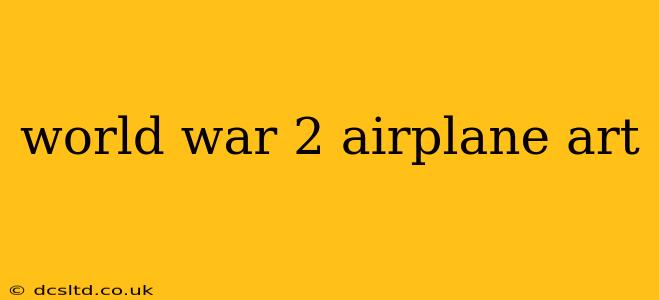World War II's impact resonates even today, and its legacy is vividly captured in the powerful imagery of airplane art. From the meticulously detailed nose art adorning fighter planes to the evocative paintings and illustrations depicting aerial battles, this art form offers a unique window into the experiences, emotions, and spirit of the era. This exploration delves into the fascinating world of WWII airplane art, examining its diverse styles, symbolism, and enduring legacy.
What are the different styles of WWII airplane art?
The styles of WWII airplane art are incredibly diverse, reflecting the global nature of the conflict and the varied artistic talents involved. We see everything from the spontaneous, often crude, nose art painted directly onto aircraft, to highly refined and technically skilled illustrations and paintings produced by professional artists both during and after the war.
Nose art, often created by the airmen themselves, typically featured pin-up girls, patriotic symbols, humorous caricatures, or depictions of the squadron's mascot. These works were often quickly executed, reflecting the immediacy and urgency of the war environment. In contrast, professional artists produced more polished pieces, often commissioned for propaganda purposes or as historical records. These could range from realistic depictions of aerial combat to more abstract representations of the war's emotional toll.
Furthermore, the style varied geographically. American airplane art often exhibited a more playful and optimistic tone, whereas artwork from other nations might reflect a more somber or propagandistic approach. The artistic styles themselves ranged from photorealism to impressionism and even abstraction, reflecting the broad spectrum of artistic approaches prevalent at the time.
What is the symbolism in WWII airplane art?
The symbolism within WWII airplane art is rich and multifaceted, often conveying messages of patriotism, courage, camaraderie, and even defiance.
- Nose art: The pin-up girls often represented longing for home and loved ones, while patriotic symbols reinforced national identity and pride. Humorous or defiant imagery reflected the airmen's resilience and gallows humor in the face of danger.
- Propaganda art: This type of artwork often aimed to boost morale, demonize the enemy, and celebrate military victories. Images of triumphant Allied aircraft soaring above defeated Axis forces were common themes.
- Personal expressions: Many works reflected individual experiences and emotions, depicting the fear, loss, and camaraderie of wartime life. These pieces often offer the most intimate glimpses into the human side of the war.
Why was WWII airplane art created?
The reasons behind the creation of WWII airplane art were varied and often intertwined. For the airmen themselves, nose art served multiple purposes:
- Personalization: Aircraft were often the airmen's only constant companion during long deployments. Nose art allowed them to personalize their machines, creating a sense of ownership and identity.
- Morale booster: The humorous or defiant nature of much nose art helped to maintain morale in the face of danger and death.
- Good luck charms: Some designs were believed to bring good luck, offering a sense of comfort and hope.
- Unit identity: Nose art could also serve to identify a particular squadron or unit, fostering a sense of camaraderie and belonging.
Beyond nose art, professional artists created war-themed airplane art for various purposes, including propaganda, historical documentation, and simply to capture the drama and spectacle of aerial warfare.
How can I find WWII airplane art?
Finding WWII airplane art is relatively straightforward. Numerous resources are available, including:
- Museums: Many aviation museums and war museums have extensive collections of WWII airplane art, both original paintings and photographs of nose art.
- Online galleries: Numerous online galleries and auction sites feature WWII airplane art. However, it's crucial to carefully verify the authenticity and provenance of any purchases.
- Books: Many books have been published featuring WWII airplane art, offering stunning reproductions and historical context.
- Archives: National archives and military archives often hold original artwork or photographs of nose art.
What makes WWII airplane art historically significant?
WWII airplane art holds immense historical significance, offering invaluable insights into the war experience beyond traditional historical accounts.
It provides a visual record of:
- Technological advancements: The depictions of aircraft designs and technology reflect the rapid advancements in aviation during the war.
- Tactical developments: The imagery reflects the changing nature of air warfare, showing the evolution of tactics and strategies.
- Cultural expressions: The diverse styles and themes reveal the cultural diversity of the nations involved and the emotional impact of the war on individuals and societies.
- Personal narratives: The art offers glimpses into the individual experiences and perspectives of those who lived and fought during the war.
By studying this art, we gain a deeper understanding of the human cost and broader cultural consequences of WWII. The combination of artistic expression and historical context makes WWII airplane art a truly captivating and significant aspect of the war's legacy.
